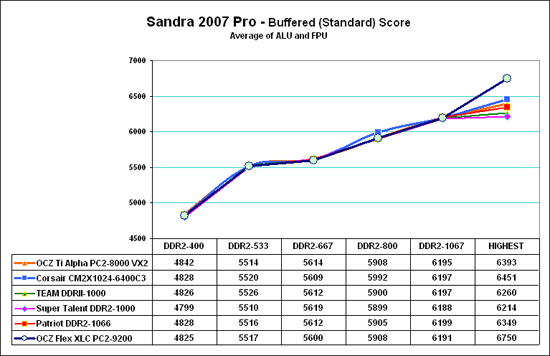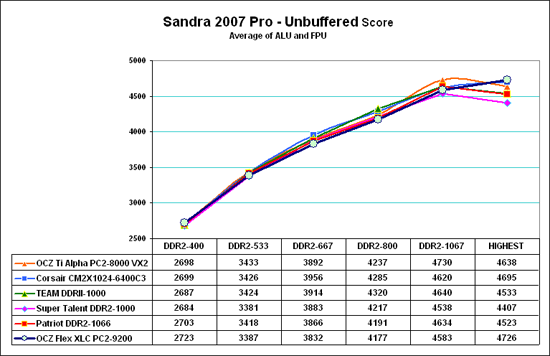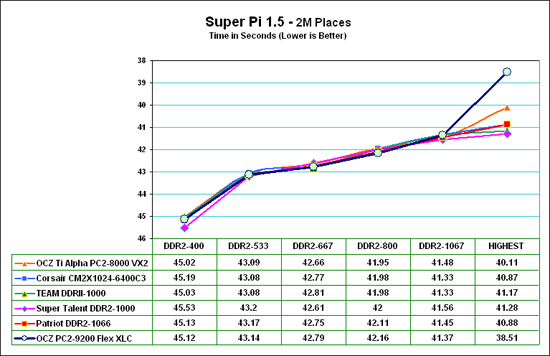OCZ Flex XLC: PC2-9200 Pushes the Envelope
by Wesley Fink on December 8, 2006 8:00 PM EST- Posted in
- Memory
Memory Bandwidth Scaling
Memory bandwidth normally improves with increases in memory speed and reductions in memory timings. This is best illustrated using Performance Scaling charts instead of Bar charts for individual speeds.
Since the results for high-end memory are so close at all tested speeds, the scale range was reduced to better show the small differences in these memory benchmark results. Please keep this in mind when viewing the charts, since a normal zero scale would make performance differences appear much smaller than these expanded scale charts. Values for the tested DIMMs at each speed are included below each chart for reference.
To evaluate memory bandwidth SiSoft Sandra 2007 Professional was used to provide a closer look at scaling for fast DDR2 memory.

The most widely reported Sandra score is the Standard or Buffered memory score. This benchmark takes into account the buffering schemes like MMX, SSE, SSE2, SSE3, and other buffering tools that are used to improve memory performance. The Buffered benchmark does not correlate well with real performance differences in games, so our memory bandwidth tests have always included an Unbuffered Sandra memory score. The Unbuffered result turns off the buffering schemes, and we have found the differences in Unbuffered results correlate well with real-world performance differences.

In both Buffered and Unbuffered tests we see the OCZ Flex XLC mirrors the best memory tested to DDR2-1066. This is exactly what would be expected since the Flex XLC is based on the same core memory chip as the other tested memories. Memory bandwidth increases dramatically at the top in buffered bandwidth (standard test). This is mostly a result of the much higher overclock in memory that could be achieved with the OCZ PC2-9200 Flex XLC compared to other Micron D-based memory. Unbuffered results also increase at the top speed, but not as dramatically as buffered results. This is also the expected result.
A look back at the page 4 tables will show that where we tested with the same CPU speed at the highest memory overclock the bandwidth increases at DDR2-1192 are smaller. The bandwidth increases at the default 2.93 GHz speed are strictly the result of increased memory speed, as CPU speed is eliminated as a variable.
We also compared results with Version 1.5 of Super Pi - comparing the time to calculate 2 million places of Pi at the different memory speeds. This benchmark measures pure number crunching.

Super Pi results continue to improve all the way to the highest speed that could be reached with stability with each memory. The second result that stands out is how close the results with all the memories really are from DDR2-400 to DDR2-1066. This is mainly a reflection of the fact that compared memories are based on the same base Micron memory chips. At the highest speed Flex XLC pulls away from the pack with the record DDR2-1172 overclock. However, the 1172 top speed at stock 2.93 GHz is very close to DDR2-1067 results. These two results show the impact of CPU speed on calculation performance is much greater than the impact of memory speed increases.
Memory bandwidth normally improves with increases in memory speed and reductions in memory timings. This is best illustrated using Performance Scaling charts instead of Bar charts for individual speeds.
Since the results for high-end memory are so close at all tested speeds, the scale range was reduced to better show the small differences in these memory benchmark results. Please keep this in mind when viewing the charts, since a normal zero scale would make performance differences appear much smaller than these expanded scale charts. Values for the tested DIMMs at each speed are included below each chart for reference.
To evaluate memory bandwidth SiSoft Sandra 2007 Professional was used to provide a closer look at scaling for fast DDR2 memory.

The most widely reported Sandra score is the Standard or Buffered memory score. This benchmark takes into account the buffering schemes like MMX, SSE, SSE2, SSE3, and other buffering tools that are used to improve memory performance. The Buffered benchmark does not correlate well with real performance differences in games, so our memory bandwidth tests have always included an Unbuffered Sandra memory score. The Unbuffered result turns off the buffering schemes, and we have found the differences in Unbuffered results correlate well with real-world performance differences.

In both Buffered and Unbuffered tests we see the OCZ Flex XLC mirrors the best memory tested to DDR2-1066. This is exactly what would be expected since the Flex XLC is based on the same core memory chip as the other tested memories. Memory bandwidth increases dramatically at the top in buffered bandwidth (standard test). This is mostly a result of the much higher overclock in memory that could be achieved with the OCZ PC2-9200 Flex XLC compared to other Micron D-based memory. Unbuffered results also increase at the top speed, but not as dramatically as buffered results. This is also the expected result.
A look back at the page 4 tables will show that where we tested with the same CPU speed at the highest memory overclock the bandwidth increases at DDR2-1192 are smaller. The bandwidth increases at the default 2.93 GHz speed are strictly the result of increased memory speed, as CPU speed is eliminated as a variable.
We also compared results with Version 1.5 of Super Pi - comparing the time to calculate 2 million places of Pi at the different memory speeds. This benchmark measures pure number crunching.

Super Pi results continue to improve all the way to the highest speed that could be reached with stability with each memory. The second result that stands out is how close the results with all the memories really are from DDR2-400 to DDR2-1066. This is mainly a reflection of the fact that compared memories are based on the same base Micron memory chips. At the highest speed Flex XLC pulls away from the pack with the record DDR2-1172 overclock. However, the 1172 top speed at stock 2.93 GHz is very close to DDR2-1067 results. These two results show the impact of CPU speed on calculation performance is much greater than the impact of memory speed increases.










29 Comments
View All Comments
photoguy99 - Saturday, December 9, 2006 - link
Thanks for your help Wesley, it's just takes a little time for me to get my head around this stuff.Just to clarify, I think I see the answer two #2:
If you have an unlocked CPU, the only benefit to this memory is a 5-8% performance increase.
In this case I don't think it matters if you are an extreme overclocker - extreme as you wanna be - this is the only benefit you can ever get with this RAM with an unlocked CPU, no matter what you do.
If you have the cash, nothing wrong with a small performance bump for $300 extra - I am not judging anyone who buys this, just trying to clarify.
regards,
pg
photoguy99 - Saturday, December 9, 2006 - link
apologize for double post, accident...photoguy99 - Saturday, December 9, 2006 - link
Sorry for being ignorant here, but can someone help break this down:1) What % faster is FlexXLC-1150 on real life benchmarks (on average), compared to value DDR2-800, at the same CPU speed?
2) Do I understand correctly that if you have an unlocked CPU multiplier, then the only benefit to this memory ever is the % improvement from question 1?
Wesley Fink - Saturday, December 9, 2006 - link
The tables on page 4 show performance at the same 2.93GHz from DDR2-400 to DDR2-1172. There are also results on the last line for the top speed on the 975X at stock 11X multiplier - so results can be compared to previous test results. You can see the performance differences in each benchmark in those tables. Performance increases are there as speed increases, but they are extremely small. We also commented several times in the review that those shopping for value per dollar should buy a good value to mid DDR2 memory rated at least DDR2-800.Flex XLC is for extreme overclockers who want as few limits as possible on their overclcoking. With the ability to run to DDR2-1300 it allows great flexibility in OC settings.
photoguy99 - Saturday, December 9, 2006 - link
Thanks for your help Wesley, it's just takes a little time for me to get my head around this stuff.Just to clarify, I think I see the answer two #2:
If you have an unlocked CPU, the only benefit to this memory is a 5-8% performance increase.
In this case I don't think it matters if you are an extreme overclocker - extreme as you wanna be - this is the only benefit you can ever get with this RAM with an unlocked CPU, no matter what you do.
If you have the cash, nothing wrong with a small performance bump for $300 extra - I am not judging anyone who buys this, just trying to clarify.
regards,
pg
cmdrdredd - Friday, December 8, 2006 - link
Why is there no 1T memory results testing? The bandwidth scores from this memory even at DDR2-1300 are pathetic to say the least. My Current system with 2Gb crucial DDR2-667 10th anniversary running DDR2-1000 at 5-4-4-8 gets 7607 Int/7631 Float buffered scores with Sandra. This is on a P5B Deluxe with E6400 running 3.2Ghz (400x8)Wesley Fink - Saturday, December 9, 2006 - link
We try to get memory as close to stock speed and multipliers as possible in our testing, which yields comparable data but not the higher bandwidths you are seeing at extremely high bus speed overclocks. End users can get high numbers with overclocking, which are great for ego comments, but that tell us very little about comparative performance. Run your memory at the same settings and compare bandwidth. Those are numbers that relate to memory comparisons. This memory will run at 8x400 just like you are using and bandwidth will be similar to what you are seeing.The standard bandwidth scores at DDR2-1300 are pretty much in line with expectations, but the unbuffered scores are extremely low. We don't yet have an answer for why that is the case on the 680i but we are trying to find answers. The 680i runs a 2:3 ratio at that speed, where the 975X is running 1:2 at its highest speed. The underlying "strap" can make a huge difference in apparent memory performance and it is usually programmed by the board maker, and not always visible or adjustable to the end user.
1T is useful for a very small performance increase on some boards, generally below DDR2-800. However, that option is not available on all boards and it really makes a small differenc on current DDR2 platforms. The differences you are seeing in bandwidth are the result of high FSB overclocks and not 1T.
Hulk - Friday, December 8, 2006 - link
I for one feel the most important part of a memory review is what timings will it run at each frequency and at what voltage?I realize that info is in the memory reviews but always in a little table that you must click to enlarge.
Please put the timings/speed/voltage in a bar graph as well. Speed on the x-axis. Timings and voltage in the horizontal bar for each speed tested. We know that if the memory works at a certain frequency/latency/voltage the performance will be the same for any stick at those conditions.
Better yet, tell me how fast it will run 4-4-4-12 and 5-5-5-18, as well as a few other timings.
But as always the reviews are great. Thanks for your hard word.
yyrkoon - Friday, December 8, 2006 - link
I'm curious, if the savvy enthusiast used chilled air in place of water, what the end results would be. I don't think it would be hard to built something that forced cool air through these memory sticks instead of water. i.e. Chilled air in, and hot air vented out.End result should be a cooler safer system overall.
Griswold - Saturday, December 9, 2006 - link
Other than "for shits and giggles" I see no point in doing that. Water will do a better job. Remember, air is such a bad heat conductor, compared to water.A properly installed watercooling system is also very safe.